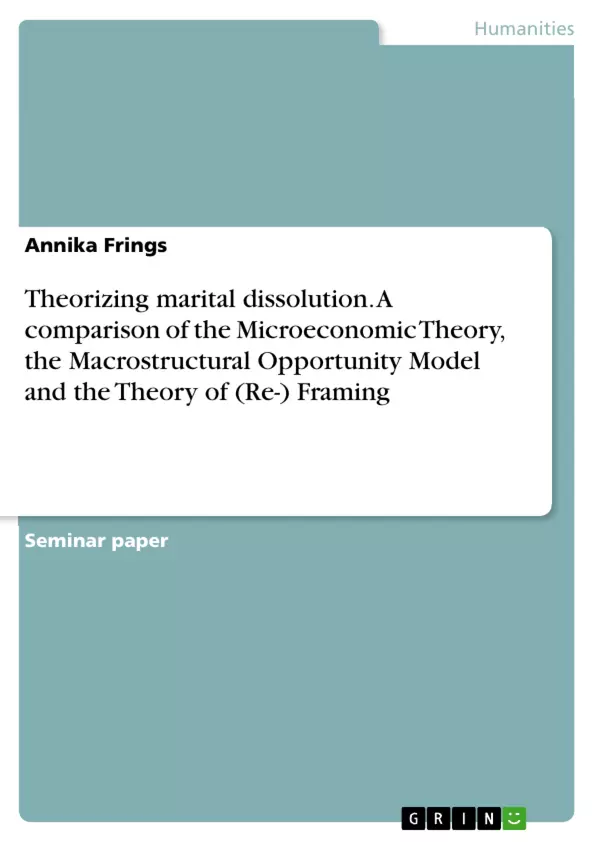The aim of this paper is to describe different theories that try to explain, why individuals respectively couples decide to dissolve their marriage.
These theories try to detect determinants and processes, which are responsible for the stability or instability of a marriage. Divorce has become an important topic in sociological research, because over the last decades, there has been a huge increase in the number of divorces. As Wagner & Weiß state in their paper of a Meta research on German divorce research, there are various existing theories concerning marital dissolution. Apart from the exchange theory, they mention the microeconomic theory of marital dissolution, to be the most used theory in German research.
Therefore I decided to give a detailed description of Gary Becker´s microeconomic theory and compare it with Esser´s theory of Reframing and South´s macrostructural opportunity model, we discussed in class. In the next part of this paper, I will first describe each theories essentials and their predictions concerning divorce risk. Whereas in the second part, I will discuss the theories concerning similarities and differences and use additional literature on marital dissolution, to give recommendation for further research.
Inhaltsverzeichnis (Table of Contents)
- Introduction
- Theories and Determinants of marital dissolution
- Microeconomic theory of marital dissolution
- Macrostructural opportunity model
- Theory of (Re-) Framing
- Discussion
- Bibliography
Zielsetzung und Themenschwerpunkte (Objectives and Key Themes)
The paper aims to analyze various theoretical perspectives on marital dissolution, focusing on the determinants and processes that influence the stability or instability of marriages. It explores the increasing prevalence of divorce in recent decades and investigates how different theories explain this phenomenon.
- Microeconomic Theory of Marital Dissolution
- Macrostructural Opportunity Model
- Theory of (Re-)Framing
- Determinants of Marital Stability and Instability
- Comparison of Theoretical Perspectives
Zusammenfassung der Kapitel (Chapter Summaries)
- Introduction: This chapter introduces the topic of marital dissolution, highlighting the growing prevalence of divorce and the need for theoretical frameworks to understand its causes. It outlines the purpose of the paper, which is to compare and contrast different theories of marital dissolution.
- Theories and Determinants of Marital Dissolution: This section presents and explores three prominent theories explaining marital dissolution: the Microeconomic Theory, the Macrostructural Opportunity Model, and the Theory of (Re-)Framing. Each theory is discussed in detail, outlining its key assumptions, predictions regarding divorce risk, and potential limitations.
- Microeconomic Theory of Marital Dissolution: This chapter focuses on Gary Becker's microeconomic theory, which emphasizes the economic aspects of marital decisions. It discusses concepts such as utility maximization, marriage-specific capital, and the role of remarriage in influencing divorce rates.
- Macrostructural Opportunity Model: This chapter explores the Macrostructural Opportunity Model proposed by South et al., which highlights the influence of social interaction and the availability of alternative partners on divorce risk. It examines the role of social structure and sex ratios in shaping divorce decisions.
Schlüsselwörter (Keywords)
The paper focuses on the key terms and concepts related to marital dissolution, such as microeconomic theory, macrostructural opportunity model, divorce risk, utility maximization, marriage-specific capital, remarriage, social structure, sex ratios, alternative partners, and theoretical perspectives.
- Citar trabajo
- Annika Frings (Autor), 2016, Theorizing marital dissolution. A comparison of the Microeconomic Theory, the Macrostructural Opportunity Model and the Theory of (Re-) Framing, Múnich, GRIN Verlag, https://www.grin.com/document/437667



